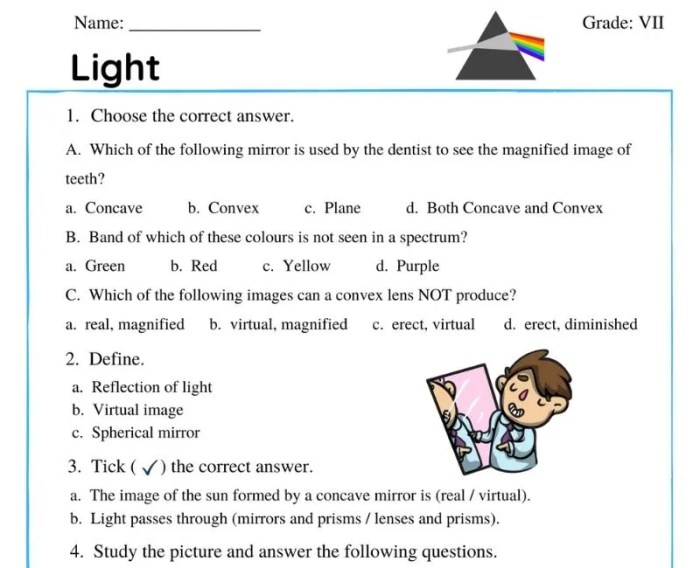Conceptual physics chapter 26 properties of light worksheet answers embarks on an enlightening journey into the captivating realm of light, unraveling its enigmatic properties and illuminating the fundamental principles that govern its behavior. Prepare to be captivated as we delve into the depths of optics, exploring the wave-particle duality of light, the intriguing phenomena of reflection and refraction, the versatility of lenses and mirrors, and the mesmerizing world of interference and diffraction.
Throughout this exploration, we will encounter practical applications of these concepts in our everyday lives, from the marvels of optical instruments to the captivating displays of nature’s light shows. Join us as we shed light on the fascinating properties of light, empowering you with a deeper understanding of the world around you.
Basic Concepts

Light is a form of electromagnetic radiation that is visible to the human eye. It is made up of photons, which are massless particles that travel at the speed of light. Light has three main properties: wavelength, frequency, and amplitude.
Wavelength is the distance between two consecutive crests or troughs of a wave. Frequency is the number of waves that pass a given point in one second. Amplitude is the height of a wave.
The electromagnetic spectrum is a range of frequencies of electromagnetic radiation. Light is only a small part of the electromagnetic spectrum. Other types of electromagnetic radiation include radio waves, microwaves, infrared radiation, ultraviolet radiation, and X-rays.
Light has a wave-particle duality. This means that it can behave like both a wave and a particle. As a wave, light can be diffracted and reflected. As a particle, light can be absorbed and emitted.
Reflection and Refraction: Conceptual Physics Chapter 26 Properties Of Light Worksheet Answers

The laws of reflection state that the angle of incidence is equal to the angle of reflection. This means that when light hits a surface, it will bounce off at the same angle that it hit the surface.
Refraction is the bending of light when it passes from one medium to another. The amount of refraction depends on the wavelength of light and the index of refraction of the two media. The index of refraction is a measure of how much light is bent when it passes from one medium to another.
Reflection and refraction are used in a variety of everyday applications, such as mirrors, lenses, and prisms.
Lenses
Lenses are devices that focus light. There are two main types of lenses: converging lenses and diverging lenses. Converging lenses focus light to a point, while diverging lenses spread light out.
The properties of a lens are determined by its focal length. The focal length is the distance between the lens and the point where light is focused. Lenses with a shorter focal length focus light more strongly than lenses with a longer focal length.
Lenses are used in a variety of optical instruments, such as eyeglasses, telescopes, and microscopes.
Mirrors
Mirrors are surfaces that reflect light. There are three main types of mirrors: plane mirrors, concave mirrors, and convex mirrors. Plane mirrors reflect light back in the same direction that it came from. Concave mirrors reflect light to a point, while convex mirrors spread light out.
The properties of a mirror are determined by its radius of curvature. The radius of curvature is the distance between the mirror and the center of the sphere from which it is cut. Mirrors with a smaller radius of curvature reflect light more strongly than mirrors with a larger radius of curvature.
Mirrors are used in a variety of everyday applications, such as mirrors, telescopes, and microscopes.
Interference and Diffraction
Interference is the superposition of two or more waves. When two waves interfere, they can produce a new wave that is either larger or smaller than the original waves. Diffraction is the bending of light around an obstacle.
Interference and diffraction are used in a variety of everyday applications, such as holography, lasers, and optical fibers.
Polarization

Polarization is the property of light that describes the direction of its electric field. Light can be polarized in either a linear or a circular fashion. Linearly polarized light has an electric field that oscillates in a straight line, while circularly polarized light has an electric field that oscillates in a circle.
Polarization is used in a variety of everyday applications, such as sunglasses, LCD screens, and optical fibers.
Expert Answers
What is the electromagnetic spectrum?
The electromagnetic spectrum is the range of all possible frequencies of electromagnetic radiation. It includes visible light, ultraviolet radiation, infrared radiation, microwaves, radio waves, and gamma rays.
What is the wave-particle duality of light?
The wave-particle duality of light refers to the fact that light exhibits both wave-like and particle-like properties. As a wave, light can undergo interference and diffraction. As a particle, light can transfer energy in discrete packets called photons.
What are the applications of lenses in optical instruments?
Lenses are used in a wide variety of optical instruments, including telescopes, microscopes, cameras, and eyeglasses. Lenses can be used to focus light, magnify images, and correct vision.
What are the applications of mirrors in everyday life?
Mirrors are used in a wide variety of applications in everyday life, including mirrors for personal grooming, mirrors for traffic safety, and mirrors for optical instruments.
What is the concept of polarization?
Polarization refers to the orientation of the electric field of an electromagnetic wave. Light can be polarized by passing it through a polarizing filter.